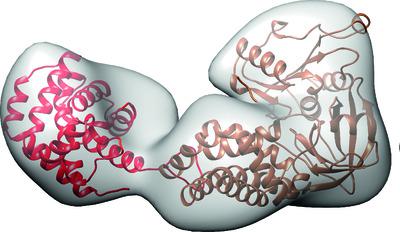当前位置:
X-MOL 学术
›
Acta Cryst. D
›
论文详情
Our official English website, www.x-mol.net, welcomes your feedback! (Note: you will need to create a separate account there.)
Low‐resolution structures of modular nanotransporters shed light on their functional activity
Acta Crystallographica Section D ( IF 2.2 ) Pub Date : 2020-12-02 , DOI: 10.1107/s2059798320013765 Yuri V Khramtsov 1 , Anastasiia D Vlasova 1 , Alexey V Vlasov 2 , Andrey A Rosenkranz 1 , Alexey V Ulasov 1 , Yury L Ryzhykau 2 , Alexander I Kuklin 2 , Anton S Orekhov 2 , Ilia B Eydlin 2 , Georgii P Georgiev 1 , Valentin I Gordeliy 2 , Alexander S Sobolev 1
Acta Crystallographica Section D ( IF 2.2 ) Pub Date : 2020-12-02 , DOI: 10.1107/s2059798320013765 Yuri V Khramtsov 1 , Anastasiia D Vlasova 1 , Alexey V Vlasov 2 , Andrey A Rosenkranz 1 , Alexey V Ulasov 1 , Yury L Ryzhykau 2 , Alexander I Kuklin 2 , Anton S Orekhov 2 , Ilia B Eydlin 2 , Georgii P Georgiev 1 , Valentin I Gordeliy 2 , Alexander S Sobolev 1
Affiliation

|
Modular nanotransporters (MNTs) are multifunctional chimeric polypeptides for the multistep transport of locally acting cytotoxic agents into the nuclei of cancer target cells. MNTs consist of several polypeptide domains (functional modules) for the recognition of a cell‐surface internalizable receptor, pH‐dependent endosomal escape and subsequent transport into the nucleus through the nuclear pores. MNTs are a promising means for cancer treatment. As has been shown previously, all of the modules of MNTs retain their functionalities. Despite their importance, there is no structural information available about these chimeric polypeptides, which hampers the creation of new MNT variants. Here, a low‐resolution 3D structure of an MNT is presented which was obtained by atomic force microscopy, transmission electron microscopy and small‐angle X‐ray scattering coupled to size‐exclusion chromatography. The data suggest that the MNT can adopt two main conformations, but in both conformations the protein N‐ and C‐termini are distanced and do not influence each other. The change in the MNT conformation during acidification of the medium was also studied. It was shown that the fraction of the elongated conformation increases upon acidification. The results of this work will be useful for the development of MNTs that are suitable for clinical trials and possible therapeutic applications.
中文翻译:

模块化纳米转运蛋白的低分辨率结构揭示了它们的功能活性
模块化纳米转运蛋白 (MNT) 是多功能嵌合多肽,用于将局部作用的细胞毒剂多步转运到癌症靶细胞的细胞核中。MNT 由几个多肽结构域(功能模块)组成,用于识别细胞表面可内化受体、pH 依赖性内体逃逸以及随后通过核孔转运到细胞核中。MNTs 是一种很有前景的癌症治疗手段。如前所述,MNT 的所有模块都保留了它们的功能。尽管它们很重要,但没有关于这些嵌合多肽的结构信息,这阻碍了新 MNT 变体的产生。在这里,展示了通过原子力显微镜获得的 MNT 的低分辨率 3D 结构,透射电子显微镜和小角度 X 射线散射与尺寸排阻色谱耦合。数据表明 MNT 可以采用两种主要构象,但在这两种构象中,蛋白质的 N 端和 C 端相距遥远,互不影响。还研究了培养基酸化过程中 MNT 构象的变化。结果表明,酸化后延长构象的比例增加。这项工作的结果将有助于开发适合临床试验和可能的治疗应用的 MNT。还研究了培养基酸化过程中 MNT 构象的变化。结果表明,酸化后延长构象的比例增加。这项工作的结果将有助于开发适合临床试验和可能的治疗应用的 MNT。还研究了培养基酸化过程中 MNT 构象的变化。结果表明,酸化后延长构象的比例增加。这项工作的结果将有助于开发适合临床试验和可能的治疗应用的 MNT。
更新日期:2020-12-02
中文翻译:

模块化纳米转运蛋白的低分辨率结构揭示了它们的功能活性
模块化纳米转运蛋白 (MNT) 是多功能嵌合多肽,用于将局部作用的细胞毒剂多步转运到癌症靶细胞的细胞核中。MNT 由几个多肽结构域(功能模块)组成,用于识别细胞表面可内化受体、pH 依赖性内体逃逸以及随后通过核孔转运到细胞核中。MNTs 是一种很有前景的癌症治疗手段。如前所述,MNT 的所有模块都保留了它们的功能。尽管它们很重要,但没有关于这些嵌合多肽的结构信息,这阻碍了新 MNT 变体的产生。在这里,展示了通过原子力显微镜获得的 MNT 的低分辨率 3D 结构,透射电子显微镜和小角度 X 射线散射与尺寸排阻色谱耦合。数据表明 MNT 可以采用两种主要构象,但在这两种构象中,蛋白质的 N 端和 C 端相距遥远,互不影响。还研究了培养基酸化过程中 MNT 构象的变化。结果表明,酸化后延长构象的比例增加。这项工作的结果将有助于开发适合临床试验和可能的治疗应用的 MNT。还研究了培养基酸化过程中 MNT 构象的变化。结果表明,酸化后延长构象的比例增加。这项工作的结果将有助于开发适合临床试验和可能的治疗应用的 MNT。还研究了培养基酸化过程中 MNT 构象的变化。结果表明,酸化后延长构象的比例增加。这项工作的结果将有助于开发适合临床试验和可能的治疗应用的 MNT。



























 京公网安备 11010802027423号
京公网安备 11010802027423号